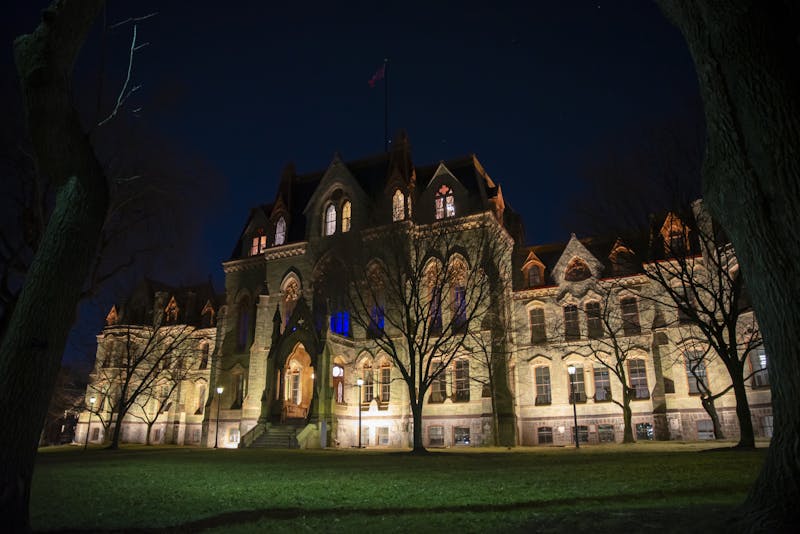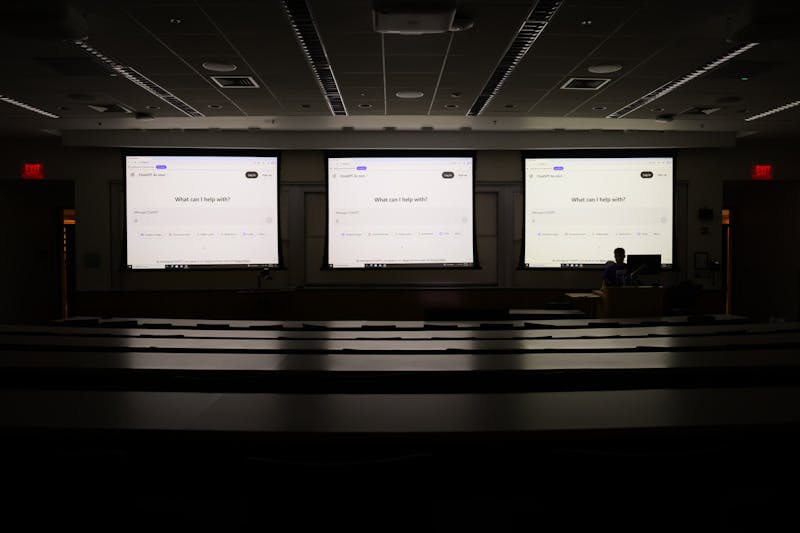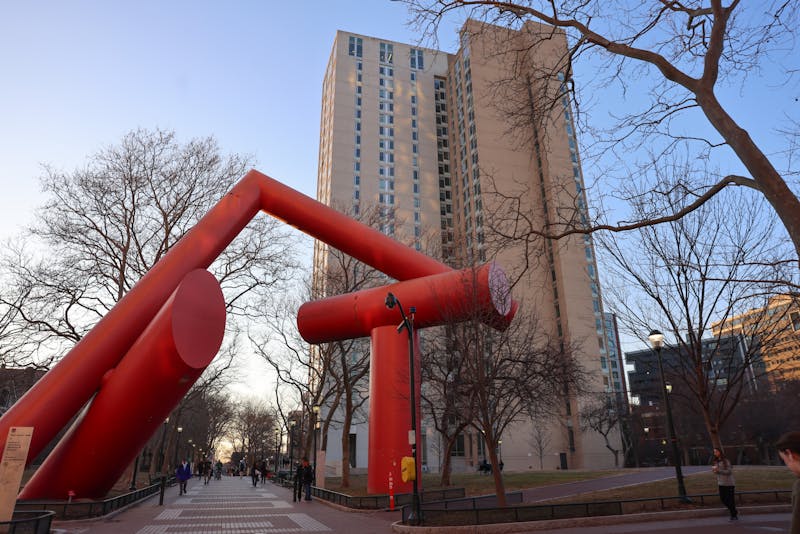
NEW ORLEANS -
Linda Nunnery couldn't be happier. She lost her home and her job to Katrina, but that's all just a memory now that Habitat for Humanity has provided her with a pristine new house in New Orleans' Upper Ninth Ward. It's still three weeks before she expects to move in, but Nunnery is so excited that she's already started stocking her bright purple house - which volunteers from Penn helped lay the foundation for - with bathroom and cleaning supplies.
Just across the street and a few hundred feet down the road, Henry Swanson is seething. It's clear enough from the signs posted in his front yard ("MAKE LEVEES NOT WAR," one screams), but talk to him about how he can't get the city to come connect his electricity and the old jazz vocalist transforms from a defeated porch-sitter to a fire-eyed zealot.
"Sometimes I think I can't be from America," he intones, nostrils flaring. "Americans can't go through this."
On the 4000 block of North Roman Street, civilization stares squalor in the face. On one side of the road, a dedicated non-profit fueled in large part by college students' youthful idealism is making a real, but, in truth, limited, difference. On the other side, devastated houses lie untouched, neglected by a government that has been, in Swanson's words, "as efficient as a basketful of crabs."
Since the storm, thousands of volunteers - including over a hundred from Penn - have descended on New Orleans to help build homes with Habitat. So far, though, they have only managed to construct 34 houses. Habitat's Executive Director in New Orleans, Jim Pate, explained that red tape kept the organization from starting work until last March, and he expects 50 to 60 to be complete by the end of the year. According to Pate, other nonprofit efforts in the city have resulted in just four additional new homes being built since the storm.
Clearly, Habitat can only do so much. Less than 50 percent of the half-million people evacuated during the storm have returned, and many have stayed away because they simply have nowhere to live. Fourteen thousand people were forced to flee the relatively impoverished and extremely hard-hit Lower Ninth Ward alone. Drive through the Lower Nine today and almost none of them have returned. With houses looking just as bent and twisted as they did a year ago, it's clear that little serious recovery work has been done. Seeing a walking, talking human being in the streets feels rarer than coming upon a busted car with shattered windows or a boat beached on a pile of trash and rubble.
Sabrina Jacks, a volunteer coordinator at Habitat's Upper 9th Ward Musician's Village site, is proud of her group's work, but she wishes they could do more.
"I think we all do," she said.
Engineering and College senior Steve Davidson said it was that frustration that compelled him to make service trips to New Orleans both over spring break and during the summer. He's also helped plan five trips to the area for Penn students, faculty and staff.
Along with about 100 other volunteers, he spent a long, grueling day last March digging out the foundation for Nunnery's home; he says he's "thrilled" to know that his efforts have yielded real results.
At the same time, though, he's concerned that the lack of a overall government planning will prevent people from being "able to rebuild their lives as much as their homes."
Penn political-science professor John DiIulio had a similar experience when he headed south in May with a group from Penn. He said he was "amazed" by the efforts of Habitat and all the students that volunteered with him but frustrated by the government's response.
What he remembers most about his time in New Orleans is working in the 9th Ward's streets with the students - and that's it.
"It wasn't like there were earth movers and heavy machinery in every direction," he said, noting that reinforcements were nowhere to be found.
"I feel a little bit for the students," he said, "not being able to say, 'Look, the kinds of efforts that you're making are supported by a much wider effort from government."
The problem is that nobody in the local, state or federal government seems willing to make a decision, according to Craig Colten, a geography and anthropology professor at Louisiana State University. Colten thinks the 9th Ward is doomed to be drowned again by the next hurricane, so it ought to be given up. Others, like DiIulio, support a massive rebuilding effort.
Despite their disagreement, both say that the government's inability to choose a direction has been disastrous.
"What the mayor has decided is that he wants the market to operate," Colten said. Mayor Ray Nagin's plan is essentially to see who moves back and which neighborhoods are repopulated and proceed from there with a more structured renewal. Colten believes, though, that without any coordinated direction, people won't know whether to come home and rebuild or seek housing elsewhere.
"That's a recipe for disaster," he says.
Lower 9th Ward resident Ronald Tonth is learning that firsthand.
A carpenter and painter by trade, he returned to his home in June to rebuild it himself. A squat, brick building, his house is well on its way to completion, but nearly every other building on his block lies untouched since the storm. There are caved-in roofs and weeds grown to the height of doorposts - some of his neighbors' houses look almost as though they've been crumpled up like wads of paper about to be thrown in a wastebasket.
"See anybody here with any money to build their houses?" he asks.
When Tonth finally finishes his reconstruction, he will almost certainly be alone. Surrounded by empty houses all spray-painted with "X"s and a series of inspector's markings, (which indicate, among other things, how many people died inside), it's difficult to imagine city services as basic as trash collection being extended to him, let alone having a local school for his kids to attend.
After all, Swanson has been waiting over a month just to get his electricity connected. Watching Habitat's persistently efficient effort across the street has made it even more maddening: In one day, he says, he watched five Habitat houses get their electricity connected. Despite his frustration, Swanson says he can't help but admire what's going on across the way.
"The people over there have it all together," he says. "It's like an assembly line. All volunteers; that's the beauty of it."
Nunnery can attest to that effectiveness. She lives on the other side of the mirror and can't stop expressing gratitude to the Penn students - and all the volunteers for that matter -who contributed to building her house at 4007 North Roman.
"I really thank God for them," she says.
Nunnery, though, represents only one person among the thousands rocked by Katrina. Habitat for Humanity, noble and effective as its efforts may be, can't help them all.
"It's great to light a single candle," DiIulio said, "But you have to have the whole electric company working."
Now that's something Henry Swanson could appreciate.
About this series: One year ago, much of New Orleans was all but destroyed by Hurricane Katrina. In this week-long series, the DP revisits the city, which, after a year of politics and promises, is still far from its former greatness. Meet the people caught up in the tragedy and see how their lives have - and more often have not - returned to normal. Today - Habitat struggles to make a difference Tomorrow - Miji Park gave up a good job to do her part Wednesday - Tulane students try to return to normalcy Thursday - Images from the aftermath Friday - A magnet school washed away in the storm
The Daily Pennsylvanian is an independent, student-run newspaper. Please consider making a donation to support the coverage that shapes the University. Your generosity ensures a future of strong journalism at Penn.
DonatePlease note All comments are eligible for publication in The Daily Pennsylvanian.







